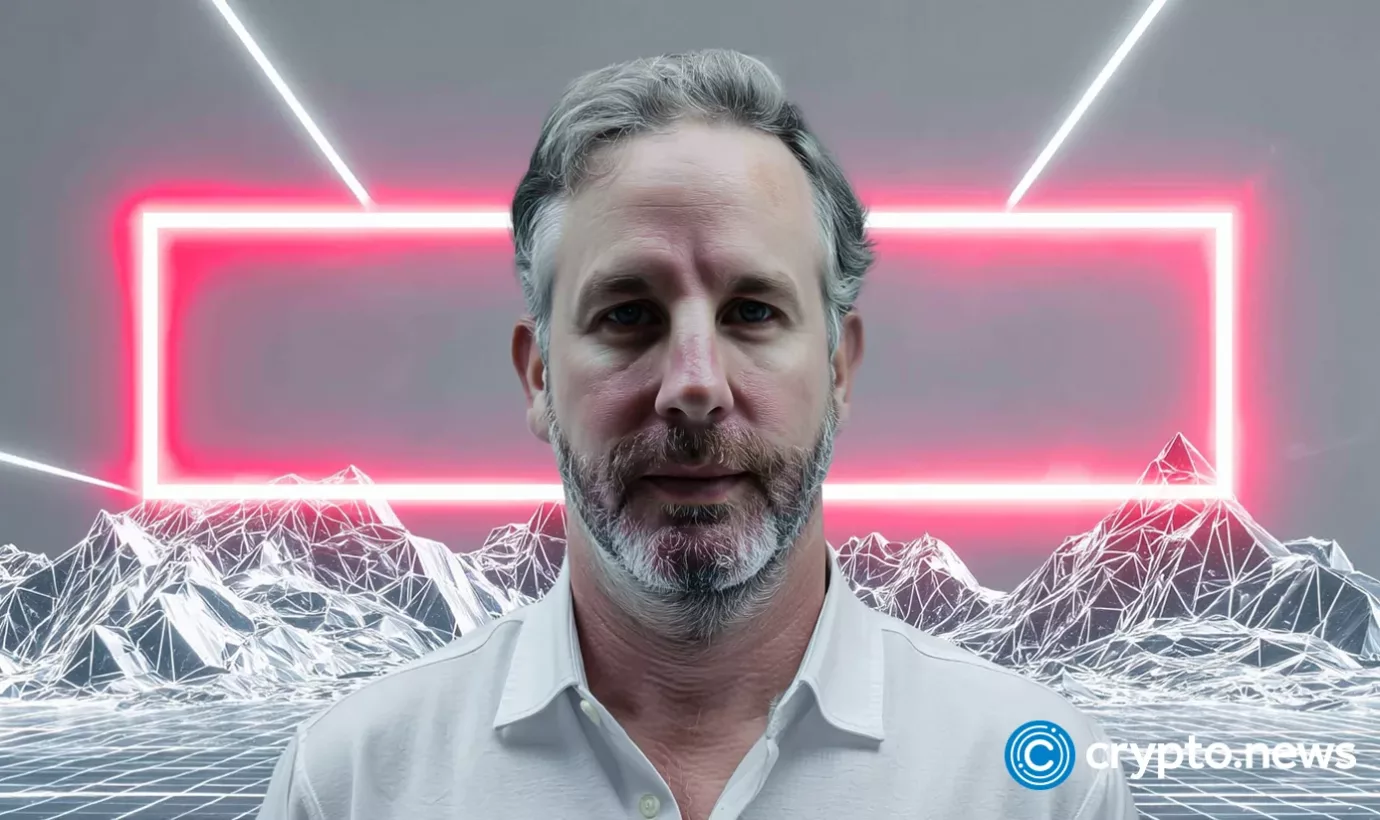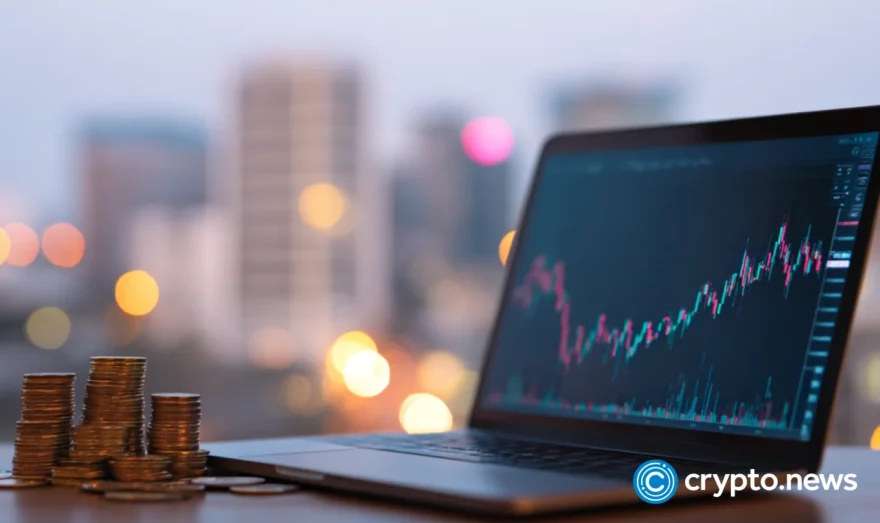Interview | Inside Avalanche Treasury’s $200m AVAX-backed public launch

Bart Smith, CEO of Avalanche Treasury, explains why he thinks enterprises should build on Avalanche.
- Avalanche Treasury CEO Bart Smith explained why the company launched its treasury strategy
- In the next five to ten years, there will be a super-cycle of blockchain adoption
- He explains how Avalanche enables businesses to build custom blockchains with privacy features
Bart Smith, the former executive at the quant trading firm Susquehanna, is taking Avalanche Treasury Co. public through a $675 million SPAC merger. Backed by a $200 million discounted AVAX purchase from the Avalanche Foundation, the company plans to build a billion-dollar ecosystem fund to give investors better exposure to the Avalanche blockchain.
In an interview with crypto.news, Smith explained why the timing is right for blockchain adoption. He also explains what sets the Avalanche apart from other smart contract networks, and why its architecture makes it best positioned for enterprise adoption.
crypto.news: Avalanche Treasury recently announced its launch through a SPAC merger. What motivated this move?
Bart Smith: I started my career in asset management and trading. I founded an ETF firm that focused on emerging markets, and we eventually sold it to Columbia Funds. After that I spent thirteen years at Susquehanna, where I ran the ETF group and later the credit-trading business. From 2014 onward, I was responsible for everything related to digital assets.
Back in 2014, we were simply buying Bitcoin long for the firm. During the ICO boom in 2017, we built what I believe was one of the first Wall Street market-making desks for crypto. Over time, we did a lot of direct investing. Because of regulatory limits, we moved that business offshore, so Susquehanna Crypto operated from the Bahamas with offices in London and Hong Kong.
The motivation for creating Avalanche Treasury came from several things. The first was the improvement in regulatory clarity. People underestimate how major that shift is. It now allows institutions and businesses to use blockchain technology to make their operations more efficient. That opens opportunities across different sectors such as gaming, finance, and enterprise software.
At my previous firm, we were one of the largest investors in Avalanche’s (AVAX) most recent round, alongside Dragonfly, which co-led the initial seed round about five or six years ago. I have been positive on Avalanche for a long time. When we started discussing a treasury, I originally viewed it from an investor’s standpoint, but the more I considered it, the more I realized this could become a better vehicle for gaining crypto exposure.
Many institutions either cannot or prefer not to buy spot crypto on unregulated exchanges. Most cannot open a Coinbase account, and U.S. firms cannot access Binance. Their natural fallback is to look at ETFs. I ran one of the largest ETF groups for a decade. ETFs are excellent wrappers, but because they must offer primary-market liquidity every day, that structure limits what can be done inside them.
A listed and regulated product that investors can trust—one that is audited and overseen by the SEC—combined with a permanent-capital structure, lets us avoid daily redemptions. We do not have to keep a large liquid buffer just in case someone buys in or redeems. That freedom allows us to be far more strategic with how we deploy capital.
When you look at stablecoins or networks such as Solana (SOL), Avalanche, and Ethereum (ETH), much of the economic value created by applications or subnets never flows directly to the token. Avalanche Treasury can invest in those areas directly. We can participate in DeFi, validator operations, or make small direct investments in new applications being built on Avalanche. The value from that activity accrues to shareholders through a listed, regulated product.
I believe we are entering a five- to ten-year super-cycle for blockchain adoption. I wanted to focus my energy on that opportunity, and I think Avalanche is the most undervalued platform and the one best positioned to win in several verticals.
CN: You mentioned liquidity. Can you illustrate the difference between liquidity in a publicly traded stock and in a top-ten or top-twenty crypto token?
BS: It depends on several factors, starting with where you live. If you are in the United States and cannot access Binance spot markets, you are missing the biggest pool of liquidity. You also cannot trade on OKX or Bybit. Coinbase is among the largest exchanges in the world, but it represents only a small slice of overall liquidity.
For a U.S. institutional investor, even if compliance allowed trading on unregulated foreign exchanges, without access to all of them, you would still see only part of the market.
We are also going to see more digital-asset treasuries listing publicly. Many of these will come from companies that failed in other lines of business and are now pivoting into crypto. Some of those will hardly trade at all. Listing on an exchange, even the NYSE or Nasdaq, is not a solution by itself. Real liquidity requires investor interest and professional market makers who quote prices throughout the day so that both retail and institutional investors have someone to trade with.
Liquidity depends on who you are, where you operate, and what kind of leadership and strategy the treasury has. If the project attracts attention and offers tangible benefits, then people will want to trade it.
CN: Are you seeing real institutional demand for Avalanche and for Avalanche Treasury?
BS: Yes. The early demand has been extremely encouraging. There is a sense among investors that they missed the opportunity with Bitcoin and Ethereum. Those assets have been discussed for a decade, and many investors now assume the major gains are behind them. Bitcoin’s role as digital gold is well understood, but it does not provide industrial or enterprise utility.
Avalanche is different. I view it as an operating system that businesses can build on. It is essentially enterprise software that companies can integrate into their operations so they can customize blockchain use for their own needs while remaining connected to the wider ecosystem.
With better regulatory clarity, companies can finally implement blockchain technology. They do not want to store private information on public blockchains. They require KYC, AML, and the ability to permission access in ways that fit their business models. Outside Avalanche, the only real option is to build an L2 on Ethereum, which is complex and requires teams of developers who understand those environments.
Avalanche lets them create their own L1 and customize it as needed. Ava Labs provides direct support for that process. Businesses get a partner they can work with and an infrastructure that makes sense to them. That combination is what has been resonating with institutional investors.
CN: You mentioned that Avalanche lets businesses build their own networks. How is Avalanche different from other chains in that regard?
BS: Avalanche has three different chains: the P-Chain, the C-Chain, and the X-Chain. The C-Chain was specifically designed to let people build what used to be called subnets, which are now referred to as L1s. You can essentially build on top of the Avalanche blockchain while creating your own fork of it. That lets you customize certain factors, but your network is still tied into the broader Avalanche ecosystem.
So you’re building another chain that sits beside the others. The liquidity loop is effectively infinite because your transactions are not bundled with everyone else’s. You can have your own native token that trades within the Avalanche cross-chain environment, and all of your transactions are secured by the Avalanche network itself.
The advantage for a business is that you own your economic stack. You control the security and permissions, and you can KYC participants. You also gain the benefit of Avalanche’s validators securing your transactions. Since Avalanche is EVM compatible, your custom chain can connect directly to the Ethereum Virtual Machine. That means you have interoperability with the wider EVM ecosystem.
For many businesses, that is a simple and powerful proposition. Compared to building a custom L2 on Ethereum, which is technically complicated and less secure, Avalanche offers a complete end-to-end setup that makes enterprise use much more practical.
CN: Can you give examples of how that approach is being used?
A good example is the state of Wyoming. They are planning to issue their own stablecoin built on Avalanche. They want to use it to distribute things like tax returns or state benefits, for example, unemployment or welfare payments, through a debit card system. Because it is built on Avalanche, they can make it private and customized. People’s personal information is not visible on a public ledger, but the system still benefits from blockchain efficiency.
Another case is the California Department of Motor Vehicles, which has tokenized about forty-two million car titles. Right now, if you want to sell your car, you need to go to the DMV to get proof of a clean title. It is slow and administrative. If those titles exist on a blockchain built on Avalanche, you could simply permission a buyer to view that you have a clean title and that your payments are current. You could complete a sale to someone financed by Toyota without either of you physically meeting.
That is the network effect in action. If other automakers like Ford, Audi, and Mercedes-Benz also put their financing operations on chain, and every U.S. state used Avalanche to issue car titles, the entire used-car process would become far more efficient. Today, you lose around ten percent of your car’s value to a dealer because of friction in the system. Removing that friction would unlock huge value.
Each new participant adds exponential value to the network, which reflects the principle of Metcalfe’s Law. These private chains still connect back into the public Avalanche network. Every transaction can cost a small fee, and part of that AVAX is burned. So, as usage scales, scarcity increases, and the token’s value is supported by real transaction activity rather than speculation.
With Ethereum, some investors complained that when activity moved to L2s, it took away value from the main chain. How does Avalanche handle that dynamic?
BS: There is some of that effect. Businesses want to control their own financial stack. Not all the value from those private blockchains will flow directly down to AVAX, but that would never have been the case. It is unrealistic to think that a company building a private financial network would want all of its value creation to go to another token holder base.
The benefit for AVAX is that every transaction across those private or enterprise chains still connects to and secures through the Avalanche network. Transactions pay fees in AVAX, and some of those fees are burned. The more activity there is across these use cases, the stronger the underlying token economics become.
We are moving past the stage where enthusiasm in crypto was mostly about celebrity coins or NFTs. Now we are seeing actual businesses, governments, and corporations using Avalanche in real applications. That shift toward real-world adoption is what people have not fully appreciated yet.
CN: The first deal that Avalanche Treasury made was the $200 million AVAX purchase from the Avalanche Foundation. Going forward, do you plan to make similar deals with the Foundation, or will you buy on the open market?
BS: The excitement from institutions about this transaction has been very strong. They have been looking for ways to invest in blockchain technology in a structure that fits institutional standards, and until now, there really has not been a good vehicle for that.
The first priority is to close this transaction. We have announced it and now need to file with the SEC and complete that process. The goal is to finish everything in the first quarter of next year, ideally January or February, so the business combination is complete, we are listed, and investors have access to this product.
Once we are listed, the real opportunity opens up. Every other industry has been able to raise capital through public markets—software, internet, communications—but the digital-asset industry has not had that option. That is why so many crypto projects have relied on the “labs and foundation” structure in the past. Under the previous regulatory environment, they were not allowed to access public capital markets directly.
Now that we can, we will be able to meet investors where they are. Some will want convertible bonds that give them upside with protection. Others will prefer straight equity. We can also look at preferred shares, private investment in public equity (PIPE) transactions, or open-market issuance through an at-the-market program. Having that capital structure available lets us raise funds efficiently for current shareholders.
When we decided to go the SPAC route, we deliberately chose not to merge into an existing failed business. Many SPACs take that shortcut, but it creates legacy liabilities and distractions. We wanted a clean structure from day one. Even Michael Saylor still spends twenty minutes of every quarterly call talking about his software business before getting to the Bitcoin part. We did not want that situation. We wanted a pure, long-term vehicle focused entirely on digital assets.
Once the listing is complete, the conversations I have had with institutions suggest they want to engage quickly. They have said, “Once you are listed, come back to us.” They want to look at preferred shares, convertibles, and equity investments. That gives us flexibility to raise capital in whatever way is most efficient for shareholders.
CN: What about market impact? Your goal is to build a billion-dollar AVAX treasury. If you buy that much on the open market, it could move prices significantly.
BS: That is true. Fully diluted, AVAX is roughly a twenty-billion-dollar asset, depending on the price. We are very aware of liquidity dynamics. I ran one of the largest crypto market-making firms in the world, so if there is one area where I am confident, it is understanding crypto liquidity.
We are taking a long-term approach to acquiring assets. We want to be efficient and thoughtful in how and where we deploy capital. That may mean accumulating slowly over time, in a way that minimizes market impact. We will always be mindful of how our buying affects the ecosystem and the price of AVAX.
CN: What are some things that investors may be overlooking when it comes to AVAX or the broader crypto market?
BS: What I see in the market right now is that everyone is focused on central bank policy. The conversation is about how many rate cuts are coming, what tariffs might do to inflation, and all these macro factors. Crypto prices, including Bitcoin, Ethereum, and Avalanche, still react mainly to those macro shifts. They trade as higher or lower beta versions of the same theme.
From where I sit, there is incredible progress being made on certain platforms, and less on others, but they are still valued in the market as if they are all the same kind of macro asset. I think that changes in 2026. Institutions will start doing real research, comparing different blockchains on their fundamentals. When that happens, Avalanche stands to benefit a lot, because its underlying attributes and success so far have not been fully appreciated by the market.
That is what I am most excited about: as adoption grows and more real-world use cases appear, people will begin to look at these networks with a more critical lens. That shift will be very positive for Avalanche.













